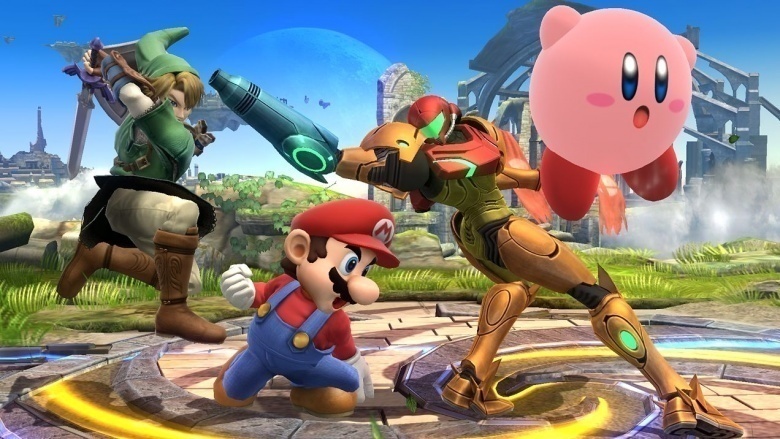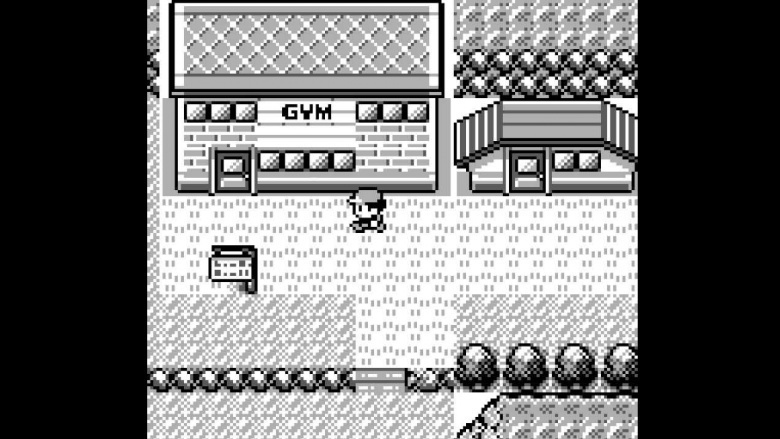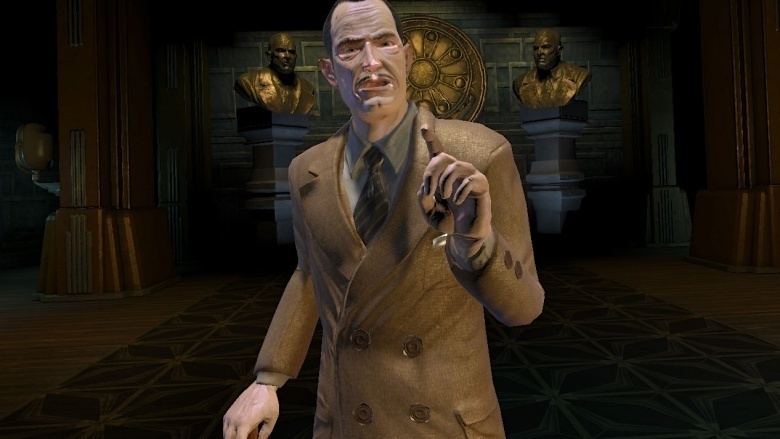Fan Theories That Will Make You See Games Differently
While it's true that most of the video games we play have some kind of narrative to help add flavor to the proceedings, a lot of gamers take it upon themselves to creatively add to that narrative. Players who aren't satisfied with what's been presented to them often take details from the games' events to give life to theories that can totally alter how we interpret its story. Some of these lore-warping ideas might require a tin hat or two, but there's no denying that they might have a kernel of truth in them. Let's look back at some of our favorite games of all time with some mind-blowing fan theories. As you'd expect, there are major spoilers ahead.
Super Smash Bros. is about the creator's role in the series
Super Smash Bros. is a beloved fighting game franchise that's broken up as many friendship circles as it has controllers. One theory posits that there is an overarching story present in the series and that it all goes back to the franchise's creator, Masahiro Sakurai. Consider the first game's boss, Master Hand. Many believe Master Hand represents Sakurai himself, the mastermind behind the whole superstar fracas. As the series became more popular and grew, so did the theories.
Supposedly, Nintendo was represented by Tabuu, the entity that pulled the strings and controlled Master Hand, symbolizing the company's demand for more installments. Crazy Hand, with its erratic and rebellious nature, is a symbol of Sakurai's desire to break away from the series. This is why Master Hand and Crazy Hand have trouble coordinating their attacks when you fight them together. If this theory holds any water, let's hope that future iterations of the game won't feature Arthritic and Defeated Hands.
Red's dad in Pokemon Red/Blue was there all along
Here's a theory that rethinks the whole "Red's dad is dead" thing from Pokemon Red/Blue. If you've ever played the first title in the legendary and long-running Pokemon series, then you'll know that only Red's mom is present in the game. There's little to no mention of our protagonist's dad in the game, leading us to believe that he's not in the picture.
One theory, however, offers up the idea that maybe Red's father was in the game the whole time! Supposedly, Red's father followed him on his journey to become the best there ever was (start singing the original theme song now). Remember the Gym Guide who sat there waiting at the entrance of every Pokemon Gym? He just might be Red's dad, pumping the kid up and offering him advice before a big battle. He doesn't seem to take his job as a Gym Guide seriously and only speaks to Red, ignoring other trainers completely, so maybe this theory has a ring of truth to it? Either way, we feel bad for Red's mom, who's left all alone at home while her son goes out on adventures and her ex-lover stalks him.
The Mass Effect Indoctrination Theory
This theory is crazier than a krogan hopped-up on red sand, but it's certainly an interesting one that could possibly change how you look at the controversial ending of Mass Effect 3. Originally posted on Reddit by user SvenHudson, this theory claims that Commander Shepard had been indoctrinated ever since encountering the Prothean beacon on Eden Prime at the beginning of the first game. The user who offered up the theory cites mind control as a major theme in the games, giving examples in the form of major story missions like the lab on Virmire that studied indoctrination, the Rachni Queen on Noveria, and the mind-controlling plants on Feros.
Supposedly, the Protheans used the power of indoctrination, which was a primary weapon of the Reapers, to have Shepard continue fighting their war. Shepard's auditory hallucinations was one of the signs of indoctrination. Shepard may have been a puppet, but at least this theory kind of makes it so that the Starchild seemed more than some rando that was thrown at us to force us to make arbitrary choices at the last second.
The boy in Limbo is a villain
According to this theory, the boy and girl present in Limbo died together, but it was all the boy's fault. Because of his guilt, the boy lashes out at the denizens of limbo and even wanders through it as a form of self-punishment. Though he's young, he's still very violent and even dismembered the spider at the beginning of game, tearing off its legs and then using its body as a bridge. That is some savage stuff. Because of his perceived violent nature, the other children in limbo keep their distance from him. Honestly, we'd give any kid who tears giant spiders apart and has glowing eyes a very wide berth.
Aeris was never supposed to die in Final Fantasy VII
How about this one? Aeris was never supposed to die in Final Fantasy VII, which would have prevented thousands of liters of tears from being expelled by fanboys worldwide. According to KupoNut, this theory claims that Aeris should never have been killed by Sephiroth and that her death was a last minute decision. The evidence used to support this theory includes a ledge that could occupy another person right before the final battle, the art inside the instruction manual featuring Aeris looking up at the Highwind (considering she dies long before you ever get it), and her best weapon having the ability to gain AP while everyone else's ultimate weapons offer no Materia growth.
While Aeris' death was an unforgettable and sad moment for every young JRPG fan, this theory could change how you look at everything that happens after she dies. You might even end up looking around for clues that something was changed in order to erase an instance of the game when she would have or should have appeared. Either way, we miss you Aeris!
Booker DeWitt is Andrew Ryan
Wrap your minds around this one. Forbes claims that Booker DeWitt, protagonist of BioShock Infinite, also happened to be Andrew Ryan, one of the antagonists in the original BioShock. Because of the nature of Elizabeth's Tears and the parallel universes they lead to, it is believed that crossing Rapture didn't just show us a world that could be possible, but that it showed us a different version of what happened in Columbia. Andrew Ryan was a different form of Booker/Comstock, the Little Sisters were fragmented versions of Elizabeth, the Big Daddies were the Rapture versions of Songbird, and Fontaine was just like Fitzroy. As further proof, Booker was able to use the bathysphere, which could only be activated by someone with Ryan's DNA. Would you kindly ponder this theory some more?
Portal's weighted Companion Cubes hold dead bodies
This one is a very simple and tragic theory: the weighted Companion Cubes from Portal hold the corpses of former test subjects. The biggest piece of supporting evidence that actually sparked this theory came from the achievement you get from dropping the Cube into the incinerator, "Fratricide." The theory is further supported by the presence of all the graffiti and notes left by the Ratman, some of which featured pictures of people with Companion Cubes over their faces. This theory leaves a bad taste in our mouths, even after considering how dark Portal can be. We have to pull a page out of Brad Pitt's book and ask, "What's in the box?!"
Who is Gaster in Undertale?
Undertale's Gaster was the Royal Scientist before Alphys, who then took his spot after he died. Gaster was also the person responsible for creating the CORE, the facility that provides magical electricity to the underground. There's a theory, however, that states that the skeleton brothers, Sans and Papyrus, are actually fragments of Gaster. One detail that supports this is the Aster font that comes out of Sans when he snores, which is a subtle hint because Gaster's name is a portmanteau of the fonts Wing Dings and Aster. Another detail that helps support this theory is that the brothers appeared out of nowhere one day and asserted themselves, unaware of the ruling queen. Whoever Gaster is, that crack in his sprite more than likely points to the fact that he's a broken character, so the brothers being living fragments of him isn't too outlandish a theory.
How Minecraft's Void claims your life
We all know that falling into the Void in Minecraft kills you. But do we know how? One theory suggests that the Void is actually a black hole. The theory is supported by the fact that you fall infinitely until your health is depleted, chunks at a time. Normally in the game, falling doesn't necessarily kill you; it's the impact that ultimately relegates you to the past tense. But if we were to think of the Void as a black hole, the increase of gravity during your descent would mean that your body would be snapped over and over again as it fell. This would explain why your health is depleted progressively, chunks at a time. So, you know... watch your step.
Is Luigi darker than we thought?
We all know and love Mario's lankier, somewhat goofier brother Luigi. But what do we really know about him beyond the fact that he vacuums up ghosts and has a killer headbutt? While Mario is always the hero, we often see Luigi playing second fiddle on the support team. But what if Luigi's identity and powers go beyond that of a friendly, mustachioed plumber?
One theory suggests that Luigi is the reincarnation of Count Bleck's great grandfather from Super Paper Mario. Count Bleck's great grandfather would have been the vessel for the destructive Chaos Heart, which has the power to open up the Void and destroy the universe. Some evidence to support this is in Paper Mario: The Thousand Year Door, when Luigi tells Mario about his latest adventures, a lot of which include him accidentally destroying foreign lands. Then there's the fact that he seems to be the only person with the power to make a path to the Dream World in Mario & Luigi: Dream Team. It would appear that the lanky Luigi might be brewing with world-ending powers, so remember that the next time you make fun of him.
Link might have been dead throughout all of Majora's Mask
Here's a theory that might blow your mind: Link is dead in Majora's Mask and the entire game is based on the grieving process. This theory suggests that Link has died and that all of the areas in Termina represent the different stages in the grieving process: denial, anger, bargaining, depression, and acceptance. For example, everyone in Clock Town is in denial, because there's a giant moon hanging overhead that's primed to smash them into a fine paste, but no one really bats an eye. Anger is represented by the Deku King wanting to destroy a young monkey because the Deku Princess has gone.
The next part of this theory suggests that Link himself is in purgatory and has to adventure throughout Termina in order to accept his death and move on. This might explain why Termina is populated by people who look exactly like the folks he met during his adventures in Hyrule, because the land is his own personal purgatory. And that's a total bummer.
The story behind the Purple Guy in Five Nights at Freddy's
Here's an interpretation of the Purple Guy in Five Nights at Freddy's that presents him as part of the staff at the restaurant who enjoyed killing children. His first victim was killed outside of the restaurant, so his soul was bound to the place as a marionette. Later on, during a birthday party, four kids put their friend's head into the mouth of one of the animatronics, but due to a malfunction, the kid's head was bitten by the bear. The Purple Man, seeing an opportunity to take more lives, offered to clean up the mess and hide the incident before luring the kids into a back room and murdering them.
All of the souls of the vengeful dead then occupy the animatronics at the restaurant and lash out. It's only when the Purple Guy hides in a malfunctioning suit and then dies as a result that the kids are allowed to move on. This kinda explains why they're always attacking the staff, eh?
The origin of Fallout 4's creatures
We hope you're ready for a science lesson, because here's a theory that uses cold, hard science to explain how some of Fallout 4's monstrous creatures came to be. Part of the theory points to plants having higher resistance to radiation than animals, suggesting that most of the oxygen-giving plants have survived at a higher rate than the CO2-creating animals. It's then suggested that the baby insects who were big enough to survive in an oxygen-rich environment were able to create offspring that were larger, generation after generation, resulting in those nightmares you know as Radscorpions, Bloatflies and more. All of the horrors of the Wasteland can be explained with a bit of science. Thanks, science. Thanks a lot.
Pokemon takes place after a war
Here's a popular theory that suggests that Pokemon Red/Blue takes place right after a massive war that claims the lives of many men and explains why the main character's dad is missing. This would also explain why there are so many older folks and women, because all of the young, healthy men were sent off to war. The war might also be the cause of the terrible infrastructure around the Kanto region. The lack of communication between the other regions of the world lend a bit of believability to this theory, so it makes sense that in later generations of the game, former warring regions would finally open up communication with each other. Glad we're able to see peace in our time! Even if we are battling superpowered monsters against each other, some of which are likely gods.
The truth about Kirby's ability to inhale everything
Kirby is a 200-year-old pink blob who's cute and surprisingly powerful, despite his appearances. While he's proven himself to be a damn good fighter in Super Smash Bros., there's one question about his powers that still boggles us: how does his inhale ability work? He seems to be able to inhale everything from tables full of food, enemies, and even whole forests with his ever-increasing power.
In this theory, we're presented with the fact that inside Kirby is an endless alternate dimension. He uses the low pressure within his stomach dimension and the high pressure outside of his body to create vortexes, which is how the little fluffball ends up swallowing all of his enemies. He can even become powerful enough to swallow whole worlds this way. Eat your heart out, Galactus... before Kirby does.








